
by Judy Biss | Sep 22, 2017

Cotton is largely self-pollinating but attractive to bees. Pollination by bees can increase seed set per boll. Photo by Judy Biss
“The happiness of the bee and the dolphin is to exist.
For man it is to know that and to wonder at it.”
Jacques Yves Cousteau
Bumble bees are among the most recognizable types of insects. They are large, colorful, and a wonder to watch. They’re also popularized in media, cartoons, and clip-art images, but beyond the popular images, bumble bees are worthy of our attention as important pollinators of both native plants and agricultural crops. They are one of hundreds of pollinating bees that are critical to the abundance of our native lands, wildlife, and also our food supply. Protection of pollinators has received national recognition and many programs are now geared towards pollinator conservation.
Why is Pollinator Protection Important?
According to the UF/IFAS publication Minimizing Honey Bee Exposure to Pesticides:
The western honey bee is conceivably the most important pollinator in Florida and American agricultural landscapes. The honey bee is credited with approximately 85% of the pollinating activity necessary to supply about one-quarter to one-third of the nation’s food supply. Over 50 major crops in the United States and at least 13 in Florida either depend on honey bees for pollination or produce more abundantly when honey bees are plentiful.
And:
“Growers also use other managed bees species, such as the bumble bee to provide field and greenhouse crop pollination services. Additionally, there are more than 315 species of wild/unmanaged bees in Florida that play a role in the pollination of agricultural crops and natural and managed landscapes. These include mining bees, mason bees, sweat bees, leafcutter bees, feral honey bees, and carpenter bees, among others.”
Pollinator Protection was formally recognized at the federal level in 2014 when the President of the United States signed an official memorandum entitled: Creating a Federal Strategy to Promote the Health of Honey Bees and Other Pollinators which outlines specific steps to increase and improve pollinator habitat. These steps are geared towards protecting and restoring populations of not only honey bees, but native bees, birds, bats, and butterflies; all of which are vital to our nation’s economy, food production, and environmental health.
Bumble Bee Biology and Ecology
There is much to learn about these fascinating insects. Here are some facts to feed your curiosity. Additional resources are listed at the end of this article.
- Bumble bees belong to the genus Bombus within the family Apidae. As such, they are related to honey bees, carpenter bees, cuckoo bees, digger bees, stingless bees, and orchid bees.
- There are about 50 species of North American bumble bees.
- Bumble bees are social and form colonies like honey bees do, but bumble bee colonies are smaller (50 – 500 individuals) and their colonies only last one season.
- Bumble bees generally make their nests in the ground using abandoned rodent cavities or under old tree roots, etc.
- Each spring, a mated queen emerges from winter hibernation and finds a suitable underground cavity. She begins collecting nectar and pollen and laying eggs to build her colony.
- By late summer and into fall, the only surviving member of the colony are new queens.
- These queens mate and then they hibernate during winter 2-5 inches deep in the soil. The following spring these queens emerge and start new colonies, repeating the annual cycle.
- Bumble bees are adapted to a wide range of environmental conditions and can forage in cooler, cloudier, and wetter weather better than other bees. Because of this adaptation, they are generally the first bees out in early spring and the last bees out in the fall.
- Since bumble bees are adapted to a wide range of environmental conditions, they are also able to feed on a wide variety of flowering plants.
- Bumble bees do make honey, but only enough to feed the colony during bad weather when they are unable to go out and forage.
- Bumble bees, like the blueberry bee collect pollen from certain flowers using a unique behavior called “buzz pollination,” or “sonication.” This behavior is not found in European honey bees. Some plants, blueberries for example, hold tightly to their tiny pollen. Bumble bees and blueberry bees grab the flower structure and powerfully vibrate their wings while holding onto the flower. Their whole body vibrates and literally shakes the pollen lose from the flower.
- Besides blueberries, other commercially important food crops that benefit from “buzz pollination” include, tomatoes, peppers, and cranberries.
- Bumble bees are so effective at pollinating important food crops that they are raised commercially and sold to greenhouses to pollinate produce such as tomatoes, peppers, and strawberries.
Create Your Own Pollinator Pasture
You can help increase the abundance and health of bumble bees, other native pollinators, and honey bees by creating nectar and pollen rich bee pastures. These pastures can be filled with annual plants, which grow from seed each year, perennial plants, which return and spread on their own each year, various flowering shrubs and trees, or any mixture of above. You can also manage existing natural areas and woodlands by employing recommended prescribed fire regimes, non-native invasive plant control, and other practices to encourage a diversity of native pollinator plants.
The ideal bee pasture is one in which flowers are blooming as continuously as possible throughout the year. Research shows bees thrive best in open sunny pastures that are as large as possible, with a diversity of plants types. While flowering shrubs along woodland edges are well used by bees, a bee pasture that is allowed to become dominated by trees and shade will become less attractive to bees. A dedicated, open, sunny pasture having nectar and pollen plant diversity is best. Just as with any field you intend to plant, the first step is to collect a soil sample for analysis of existing nutrients and pH levels. (For more information on soil samples read the article Soil Test First!
Pollinator Plant Types
There are many plants that provide nutritious nectar and pollen for north Florida’s pollinators. Some examples of plants which are good pollinator food sources are maple trees, redbuds, poplars, gallberries, blackberries, palmettos, partridge pea, mint, thistles, goldenrod, asters, tickseeds, sunflowers, squash, melons, and clovers. If you purchase a bee pasture blend from a seed company, make sure it is suited for growing in north Florida and does not contain noxious, invasive, weedy plant species. The Florida Exotic Pest Plant Council maintains a listing of documented invasive plants here: List of Invasive Plant Species.
Summary and Resources
The business, biology, and botany of pollination is fascinating and critical to sustainable and diverse food production in Florida and the United States. Bumble bees are just one of the many native pollinators that frequent our forests, fields, and gardens. Consider turning your fallow lands or backyards into productive bee pasture and reap a sweet harvest.
For more information please see the resources used for this article below:
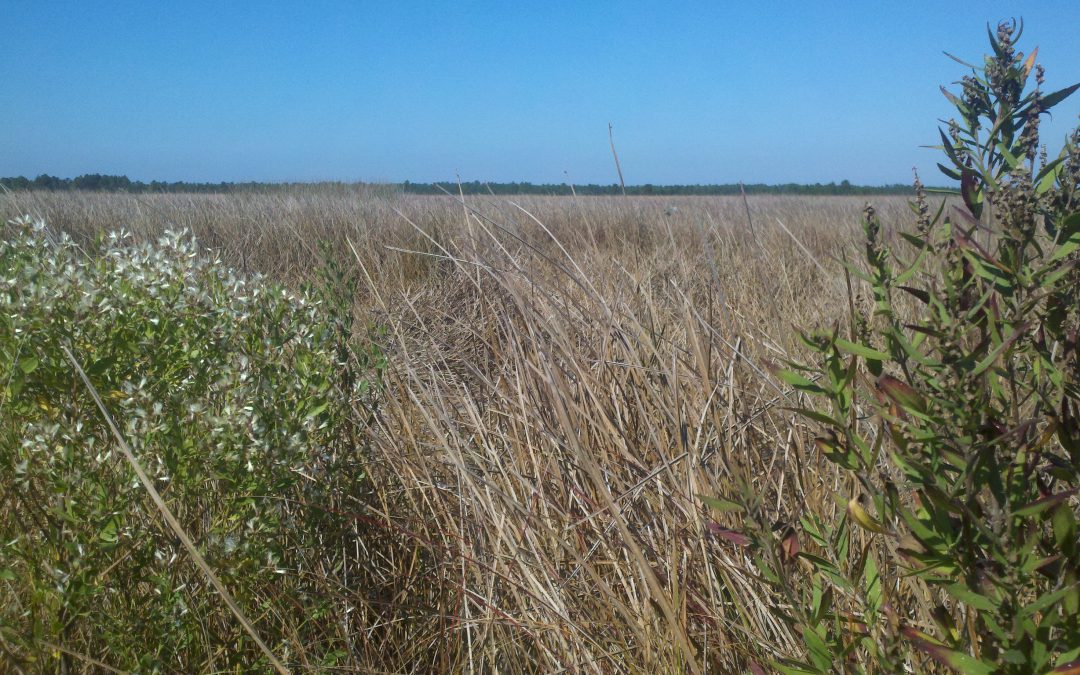
by Carrie Stevenson | Aug 25, 2017
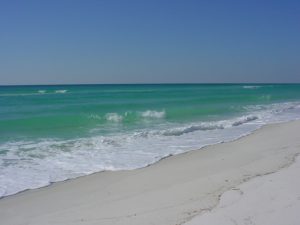
Life on the Gulf Coast can be beautiful, but has its share of complications. Photo credit: Carrie Stevenson, UF IFAS Extension
Life on the coast has tremendous benefits; steady sea breezes, gorgeous beaches, plentiful fishing and paddling opportunities. Nevertheless, there are definite downsides to living along it, too. Besides storms like Hurricane Harvey making semi-regular appearances, our proximity to the water can make us more vulnerable to flooding and waterborne hazards ranging from bacteria to jellyfish. One year-round problem for those living directly on a shoreline is erosion. Causes for shoreline erosion are wide-ranging; heavy boat traffic, foot traffic, storms, lack of vegetation with anchoring roots, and sea level rise.
Many homeowners experiencing loss of property due to erosion unwittingly contribute to it by installing seawalls. When incoming waves hit the hard surface of the wall, energy reflects back and moves down the coast. Often, an adjacent homeowner will experience increased erosion and bank scouring after a neighboring property installs a seawall. This will often lead that neighbor to install a seawall themselves, transferring the problem further.

Erosion can damage root systems of shoreline trees and grasses. Photo credit: Carrie Stevenson, UF IFAS Extension
Currently, south Louisiana is experiencing significant coastal erosion and wetlands losses. The problem is compounded by several factors, including canals dredged by oil companies, which damage and break up large patches of the marsh. Subsidence, in which the land is literally sinking under the sea, is happening due to a reduced load of sediment coming down the Mississippi River. Sea level rise has contributed to erosion, and most recently, an invasive insect has caused large-scale death of over 100,000 acres of Roseau cane (Phragmites australis). Add the residual impacts from the oil spill, and you can understand the complexity of the situation.
Luckily, there are ways to address coastal erosion, on both the small and large scale. On Gulf and Atlantic beaches, numerous coastal communities have invested millions in beach renourishment, in which offshore sand is barged to the coast to lengthen and deepen beaches. This practice, while common, can be controversial because of the cost and risk of beaches washing out during storms and regular tides. However, as long as tourism is the #1 economic driver in the state, the return on investment seems to be worth it.
On quieter waters like bays and bayous, living shorelines have “taken root” as a popular method of restoring property and stabilizing shorelines. This involves planting marsh grasses along a sandy shore, often with oyster or rock breakwaters placed waterward to slow down wave energy, and allow newly planted grasses to take root.
Locally in Bayou Grande, a group of neighbors were experiencing shoreline erosion. Over a span of 50 years, the property owners used a patchwork of legally installed seawalls, bulkheads, rip rap piles, private boat ramps, piers, mooring poles and just about anything else one can imagine, to reduce the problem. Over time, the seawalls and bulkheads failed, lowering the property value of the very property they were meant to protect and increasing noticeable physical damage to the adjacent properties.”

Project Greenshores is a large-scale living shoreline project in Pensacola. Photo credit: Carrie Stevenson, UF IFAS Extension
In 2011, a group of neighboring property owners along the bayou decided to take action. After considering many repair options, the neighbors decided to pursue a living shoreline based on aesthetics, long-term viability, installation cost, maintenance cost, storm damage mitigation and feasibility of installation. By 2017, the living shoreline was constructed. Oyster shell piles were placed to slow down wave energy as it approached the transition zone from the long fetch across the bayou, while uplands damage was repaired and native marsh grasses and uplands plants were restored to slow down freshwater as it flowed towards the bayou. Sand is now accruing as opposed to eroding along the shoreline. Wading shorebirds are now a constant companion and live oysters are appearing along the entire 1,200-foot length. Additionally the living shoreline solution provided access to resources, volunteer help, and property owner sweat equity opportunities that otherwise would have been unavailable. An attribute that has surprisingly appeared – waterfront property owners are now able to keep their nicely manicured lawns down to within 30 feet of the water’s edge. At that point, the landscape immediately switches back to native marsh plants, which creates a quite robust and attractive intersection. (Text and information courtesy Charles Lurton).
Successes like these all over the state have led the Florida Master Naturalist Program to offer a new special topics course on “Coastal Shoreline Restoration” which provides training in the restoration of living shorelines, oyster reefs, mangroves, and salt marsh, with focus on ecology, benefits, methods, and monitoring techniques. Keep an eye out for this course being offered near you. If you are curious about living shorelines and want to know more, reach out to the Florida Department of Environmental Protection Ecosystem Restoration section for help and read through this online document.
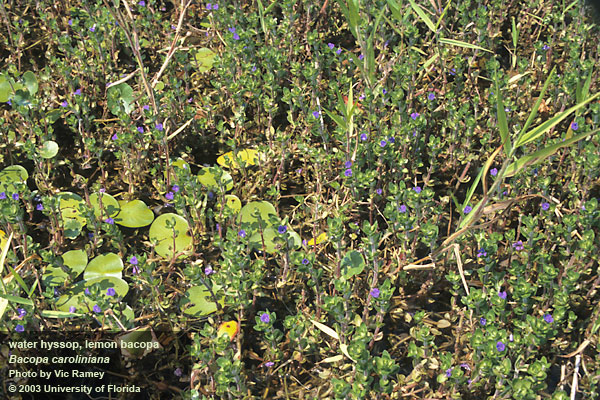
by zadwiggins | Jul 29, 2017
Bacopa caroliniana, also known as lemon bacopa, is a popular aquatic plant. It is mostly found in the southeastern United States in states such as Florida, Alabama, Georgia, South Carolina, Mississippi and even Texas. Lemon bacopa has a perennial life cycle that could make it a weed to some, or desired plant to others. Also, it can be found as a submergent plant or an emergent one.

Lemon bacopa
Photo: UF
It tends to grow near shorelines and sometimes in water that is less than 3 inches deep. Lemon bacopa has a single stem with opposite leaf growth. The leaves are thick and juicy. The reason some people enjoy and even encourage planting this plant is the pretty, attractive, purple-blue flower that sprouts. They are a popular plant used to add beauty to water gardens and to provide habitat in wetland enhancement as well as restoration projects. However, this plant can be easily propagated which could lead to it becoming weedy if not paid attention to carefully. Lemon bacopa roots easily from cuttings, so whether if it is purposely cut or by natural causes, it can easily spread and take over a water garden.
This species is very adapted and common throughout Florida. Although lemon bacopa can be weedy in some situations, it is most often considered a beneficial native plant that brings a number of desirable characteristics to almost any aquatic setting.
Source: UF IFAS EDIS publications
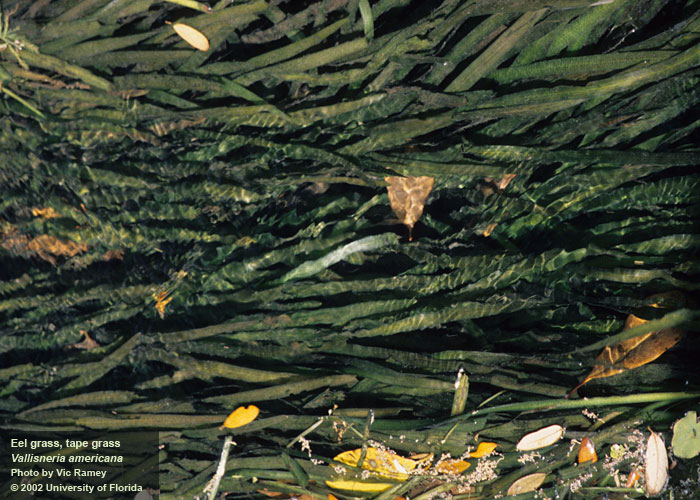
by Rick O'Connor | Apr 14, 2017
Article by Gadsden County Extension Agent
DJ Zadarreyal
Vallisneria americana, also known as tape grass or eel grass, is a common native aquatic weed in the state of Florida. Tape grass has tall, grass-like leaves that are a light green in coloration and rise vertically from the crown to the top of the water. Once the leaves reach the top of the water, they casually float along the surface.
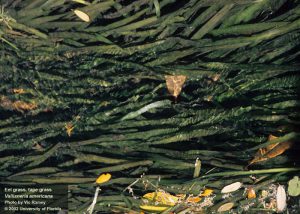
Common tape grass Vallisneria americana.
Photo: UF IFAS
The technique of propagation is by runners. These runners grow out from the crown along the sand and new plants arise from the end of them. There are separate male and female plants, although they grow on the same plant. The female flowers are on lengthy stems, which reach to the surface. However, the male flowers are loosely attached at the base of the leaves. When released, the male flowers float to the surface where they move alongside the female flowers to fertilize them.
A good way to distinguish tape grass from other weeds is to observe the leaves and the tips. Tape grass have round leaf tips while many other weeds have pointed leaf tips. In addition, tape grass is a submerged weed that possesses long, ribbon like leaves.
There are several uses for tape grass. Restoration of the pond floor is a useful purpose. One of the benefits of tape grass is that they are great oxygenators. Tape grass is also a common home based aquarium plant. They provide an eye-catching scene that fish and humans enjoy.
Source:
Guide of Tropical Fish, Everything You Need to Know About Tropical Fish










